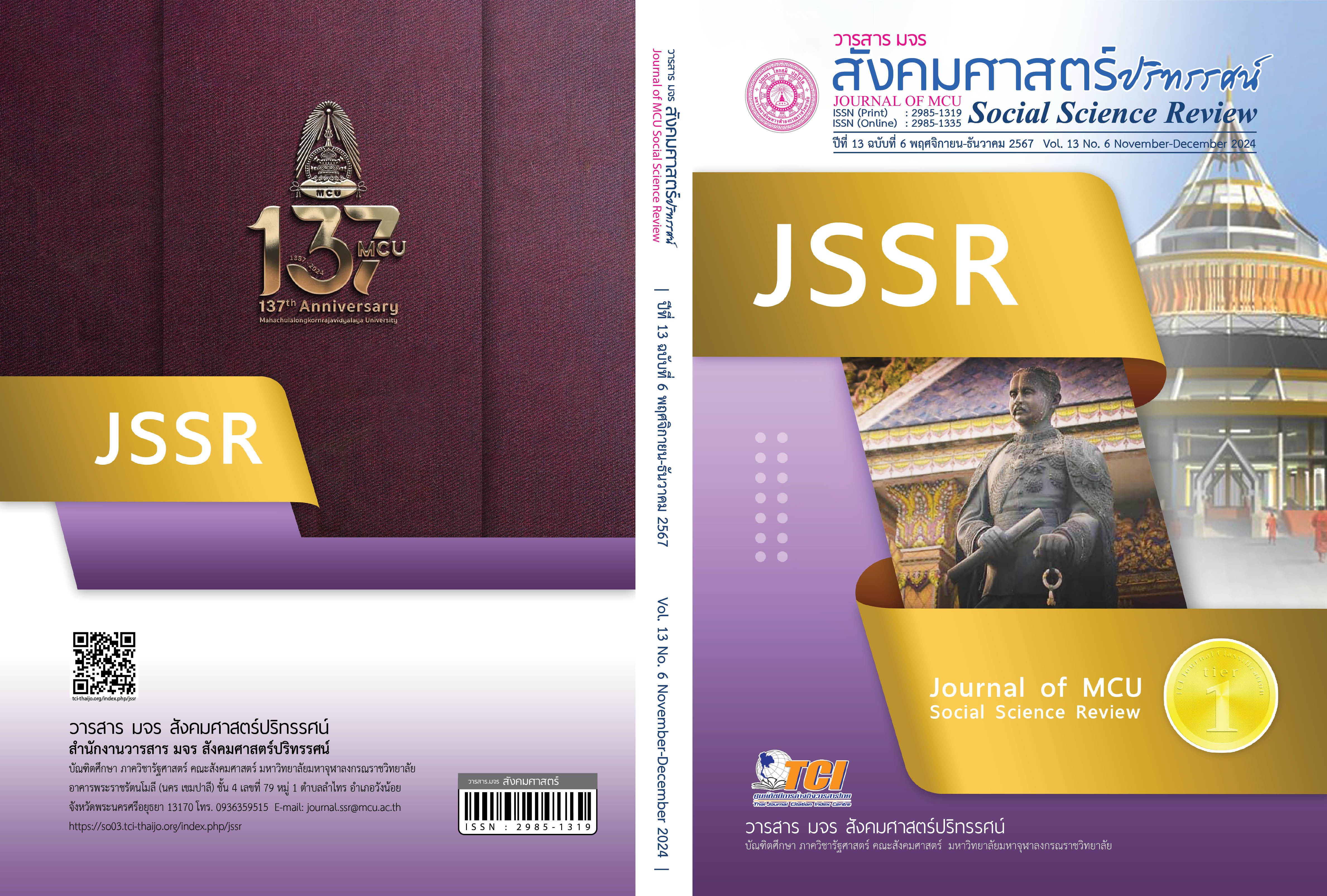การพัฒนาผลสัมฤทธิ์ทางการเรียนและความสามารถการอ่านภาษาอังกฤษเพื่อความเข้าใจโดยใช้การสอนแบบร่วมมือเทคนิค จิ๊กซอว์ร่วมกับแอปพลิเคชันคาฮูท สำหรับนักเรียนมัธยมศึกษาปีที่ 2
คำสำคัญ:
การสอนแบบร่วมมือเทคนิคจิ๊กซอว์, แอปพลิเคชันคาฮูท, การอ่านภาษาอังกฤษเพื่อความเข้าใจบทคัดย่อ
บทความวิจัยนี้มีวัตถุประสงค์ 1. เปรียบเทียบผลสัมฤทธิ์ทางการเรียนภาษาอังกฤษของนักเรียนก่อนเรียนและหลังเรียน 2. เปรียบเทียบผลสัมฤทธิ์ทางการเรียนภาษาอังกฤษหลังเรียนของนักเรียนกับเกณฑ์คะแนนเฉลี่ยร้อยละ 70 3. เปรียบเทียบความสามารถในการอ่านภาษาอังกฤษเพื่อความเข้าใจก่อนเรียนและหลังเรียน 4. เปรียบเทียบความสามารถในการอ่านภาษาอังกฤษเพื่อความเข้าใจหลังเรียนกับเกณฑ์คะแนนเฉลี่ยร้อยละ 70 กลุ่มตัวอย่าง คือ นักเรียนชั้นมัธยมศึกษาปีที่ 2 โรงเรียนศรีธรรมราชศึกษา โครงการ English Programme จำนวน 27 คน เครื่องมือที่ใช้ในการเก็บรวบรวมข้อมูลประกอบด้วย แผนการจัดการเรียนรู้ แบบทดสอบวัดผลสัมฤทธิ์ภาษาอังกฤษ และแบบทดสอบวัดความสามารถการอ่านภาษาอังกฤษเพื่อความเข้าใจ วิเคราะห์ข้อมูลโดยใช้ค่าเฉลี่ย ส่วนเบี่ยงเบนมาตรฐาน และทดสอบสมมติฐานโดยใช้ t-test
ผลการวิจัยพบว่า 1. ผลสัมฤทธิ์ทางการเรียนภาษาอังกฤษหลังเรียนสูงกว่าก่อนเรียนอย่างมีนัยสำคัญทางสถิติที่ระดับ .05 2. ผลสัมฤทธิ์ทางการเรียนภาษาอังกฤษหลังเรียนสูงกว่าเกณฑ์คะแนนเฉลี่ยร้อยละ 70 อย่างมีนัยสำคัญทางสถิติที่ระดับ .05 3. ความสามารถในการอ่านภาษาอังกฤษเพื่อความเข้าใจหลังเรียนสูงกว่าก่อนเรียนอย่างมีนัยสำคัญทางสถิติที่ระดับ .05 4. ความสามารถในการอ่านภาษาอังกฤษเพื่อความเข้าใจหลังเรียนสูงกว่าเกณฑ์คะแนนเฉลี่ยร้อยละ 70 อย่างมีนัยสำคัญทางสถิติที่ระดับ .05
เอกสารอ้างอิง
ฆนัท ธาตุทอง. (2559). หลักการจัดการเรียนรู้. นครปฐม: เพชรเกษมการพิมพ์.
ทิศนา แขมมณี. (2554). รูปแบบการเรียนการสอน : ทางเลือกที่หลากหลาย (พิมพ์ครั้งที่ 7). กรุงเทพฯ: จุฬาลงกรณ์มหาวิทยาลัย.
โรงเรียนศรีธรรมราชศึกษา. (2564). รายงานสรุปงานด้านวิชาการ ปีการศึกษา 2564 โครงการจัดการเรียนการสอนตามหลักสูตรกระทรวงศึกษาธิการเป็นภาษาอังกฤษ (English Programme). นครศรีฯ: โรงเรียนศรีธรรมราชศึกษา.
วิเชียร กำลา. (2561). การพัฒนาทักษะการอ่านภาษาอังกฤษเพื่อความเข้าใจโดยใช้กระบวนการเรียนรู้แบบร่วมมือเทคนิคจิ๊กซอว์ (Jigsaw) รายวิชาภาษาอังกฤษเพื่อการสื่อสารรหัสวิชา อ31203 ชั้นมัธยมศึกษาปีที่ 4. ร้อยเอ็ด: โรงเรียนปทุมรัตต์พิทยาคม.
อดุลย์ อุดมบัว. (2562). ผลการใช้เทคนิคการสอนแบบจิ๊กซอว์ที่มีต่อทักษะการอ่านภาษาอังกฤษเพื่อความเข้าใจของนักเรียนไทยระดับชั้นมัธยมศึกษาโรงเรียนขอนแก่น (วิทยานิพนธ์ศึกษาศาสตรมหาบัณฑิต สาขาวิชาการสอนภาษาอังกฤษ). มหาสารคาม: มหาวิทยาลัยมหาสารคาม.
อรรชนิดา หงานคง. (2559). การจัดการเรียนการสอนภาษาอังกฤษในศตวรรษที่ 21 (English Teaching in the 21st Century). วารสารสถาบันวิจัยญาณสังวร, 7(2), 303-314.
Aronson, E. et al. (1978). The Jigsaw Classroom. London: Beverly Hills, CA & Sage Publications.
ดาวน์โหลด
เผยแพร่แล้ว
รูปแบบการอ้างอิง
ฉบับ
ประเภทบทความ
สัญญาอนุญาต
ลิขสิทธิ์ (c) 2024 วารสาร มจร สังคมศาสตร์ปริทรรศน์

อนุญาตภายใต้เงื่อนไข Creative Commons Attribution-NonCommercial-NoDerivatives 4.0 International License.
เพื่อให้เป็นไปตามกฎหมายลิขสิทธิ์ ผู้นิพนธ์ทุกท่านต้องลงลายมือชื่อในแบบฟอร์มใบมอบลิขสิทธิ์บทความให้แก่วารสารฯ พร้อมกับบทความต้นฉบับที่ได้แก้ไขครั้งสุดท้าย นอกจากนี้ ผู้นิพนธ์ทุกท่านต้องยืนยันว่าบทความต้นฉบับที่ส่งมาตีพิมพ์นั้น ได้ส่งมาตีพิมพ์เฉพาะในวารสาร มจร สังคมศาสตร์ปริทรรศน์ เพียงแห่งเดียวเท่านั้น หากมีการใช้ภาพหรือตารางหรือเนื้อหาอื่นๆ ของผู้นิพนธ์อื่นที่ปรากฏในสิ่งตีพิมพ์อื่นมาแล้ว ผู้นิพนธ์ต้องขออนุญาตเจ้าของลิขสิทธิ์ก่อน พร้อมทั้งแสดงหนังสือที่ได้รับการยินยอมต่อบรรณาธิการ ก่อนที่บทความจะได้รับการตีพิมพ์ หากไม่เป็นไปตามข้อกำหนดเบื้องต้น ทางวารสารจะถอดบทความของท่านออกโดยไม่มีข้อยกเว้นใดๆ ทั้งสิ้น





